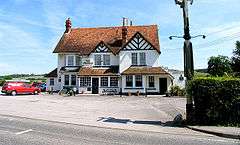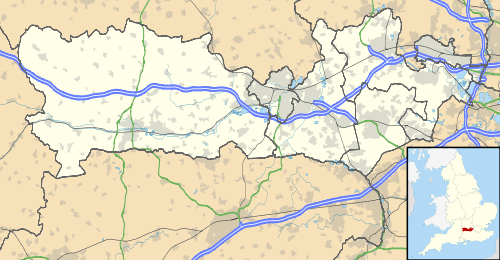Lower Basildon
Lower Basildon is a small English village in the civil parish of Basildon, near Pangbourne, in the county of Berkshire. It has a parish church of St Bartholomew.[1]
| Lower Basildon | |
|---|---|
 Typical Building Style | |
 Lower Basildon Location within Berkshire | |
| OS grid reference | SU609787 |
| Civil parish | |
| Unitary authority | |
| Ceremonial county | |
| Region | |
| Country | England |
| Sovereign state | United Kingdom |
| Post town | READING |
| Postcode district | RG8 |
| Dialling code | 01491 |
| Police | Thames Valley |
| Fire | Royal Berkshire |
| Ambulance | South Central |
| UK Parliament | |
Historic buildings
Basildon Park
The National Trust property, Basildon Park, is just above the church.[2]
Black and white
The village is well-known locally for the presence of a row of timber-framed "black-and-white" houses to the west. However, only one of these possesses a true timber frame. The remainder are built of brick, and clad with timber to resemble framing. These latter houses are said to have been designed by Edwin Lutyens, who had been commissioned to design workers' cottages for Basildon Park.
Grotto and wildlife
Basildon Grotto, or The Grotto House, is located 0.8 miles (1.3 km) to the west on the road to Streatley. The original Grotto was built in 1720 and consisted of a rock chamber filled with shells and a rock pool, but it was later destroyed. The summer house was extended at the beginning of the 19th century by Arthur Smith MP.[3] This was until about 2007 the headquarters of the Institute for Leisure and Amenity Management (ILAM). Although sold to a new owner, it remains in an empty, semi-completed state.[4][5]
To the south-east of the village there is a wildlife garden, Beale Park.[6]
Roman villa
The remains of a modest Roman villa were discovered here in 1839 during the construction of the Great Western Railway. The major finds were two superb mosaic floors, which were unfortunately destroyed almost immediately, although one was drawn in some detail beforehand by the antiquarian Charles Roach Smith. Nothing of the villa remains today.[7]
Amenities
Upper Basildon has a sub-post office (located in St Stephen's Church) and a pub-restaurant, The Red Lion.[8] Lower Basildon currently has a garage/shop and a motor repair business.
Transport
The village is covered only by a Tuesday bus service running between Goring and Reading. The nearest railway station is Goring and Streatley (2.6 miles, 4.2 km), which offers stopping trains between Didcot and London Paddington. The main A329 road connects the village with Goring and Reading.
Notable people
The agriculturist Jethro Tull was born in the parish of Basildon and is buried in the churchyard of St Bartholomew's Church in Lower Basildon, under a modern gravestone incorrectly dated 1740 – he died in 1741.[9] Tull developed his ideas at a farm called Prosperous at Shalbourne, just south of Hungerford.[10]
References
- Churches Conservation Trust. Retrieved 8 May 2014.
- NT Basildon Park site. Retrieved 8 May 2014.
- Christopher Winn: I Never Knew That about the River Thames (London: Ebury Press, 2010), p. 79.
- Basildon Parish Plan draft Retrieved 8 May 2014.
- Retrieved 17 August 2020.
- Beale Park site. Retrieved 8 May 2014.
- Berkshire History. Retrieved 8 May 2014.
- Basildon, West Berkshire site. Retrieved 8 May 2014.
- Winn, p. 79.
- "Tull, Jethro" in Cuthbert W. Johnson: The Farmer's Encyclopædia, and Dictionary of Rural Affairs (London, 1844), pp. 1056–1057.
External links
| Wikimedia Commons has media related to Lower Basildon. |